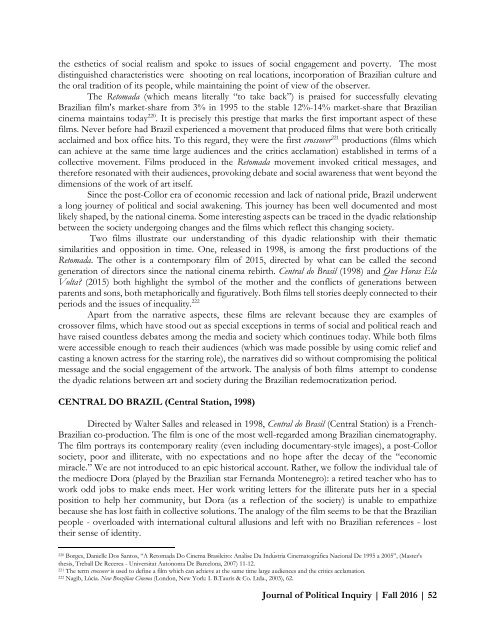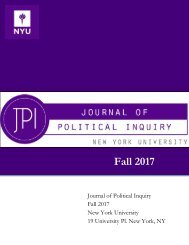Fall2016_Final
Create successful ePaper yourself
Turn your PDF publications into a flip-book with our unique Google optimized e-Paper software.
the esthetics of social realism and spoke to issues of social engagement and poverty. The most<br />
distinguished characteristics were shooting on real locations, incorporation of Brazilian culture and<br />
the oral tradition of its people, while maintaining the point of view of the observer.<br />
The Retomada (which means literally “to take back”) is praised for successfully elevating<br />
Brazilian film's market-share from 3% in 1995 to the stable 12%-14% market-share that Brazilian<br />
cinema maintains today 220 . It is precisely this prestige that marks the first important aspect of these<br />
films. Never before had Brazil experienced a movement that produced films that were both critically<br />
acclaimed and box office hits. To this regard, they were the first crossover 221 productions (films which<br />
can achieve at the same time large audiences and the critics acclamation) established in terms of a<br />
collective movement. Films produced in the Retomada movement invoked critical messages, and<br />
therefore resonated with their audiences, provoking debate and social awareness that went beyond the<br />
dimensions of the work of art itself.<br />
Since the post-Collor era of economic recession and lack of national pride, Brazil underwent<br />
a long journey of political and social awakening. This journey has been well documented and most<br />
likely shaped, by the national cinema. Some interesting aspects can be traced in the dyadic relationship<br />
between the society undergoing changes and the films which reflect this changing society.<br />
Two films illustrate our understanding of this dyadic relationship with their thematic<br />
similarities and opposition in time. One, released in 1998, is among the first productions of the<br />
Retomada. The other is a contemporary film of 2015, directed by what can be called the second<br />
generation of directors since the national cinema rebirth. Central do Brasil (1998) and Que Horas Ela<br />
Volta? (2015) both highlight the symbol of the mother and the conflicts of generations between<br />
parents and sons, both metaphorically and figuratively. Both films tell stories deeply connected to their<br />
periods and the issues of inequality. 222<br />
Apart from the narrative aspects, these films are relevant because they are examples of<br />
crossover films, which have stood out as special exceptions in terms of social and political reach and<br />
have raised countless debates among the media and society which continues today. While both films<br />
were accessible enough to reach their audiences (which was made possible by using comic relief and<br />
casting a known actress for the starring role), the narratives did so without compromising the political<br />
message and the social engagement of the artwork. The analysis of both films attempt to condense<br />
the dyadic relations between art and society during the Brazilian redemocratization period.<br />
CENTRAL DO BRAZIL (Central Station, 1998)<br />
Directed by Walter Salles and released in 1998, Central do Brasil (Central Station) is a French-<br />
Brazilian co-production. The film is one of the most well-regarded among Brazilian cinematography.<br />
The film portrays its contemporary reality (even including documentary-style images), a post-Collor<br />
society, poor and illiterate, with no expectations and no hope after the decay of the “economic<br />
miracle.” We are not introduced to an epic historical account. Rather, we follow the individual tale of<br />
the mediocre Dora (played by the Brazilian star Fernanda Montenegro): a retired teacher who has to<br />
work odd jobs to make ends meet. Her work writing letters for the illiterate puts her in a special<br />
position to help her community, but Dora (as a reflection of the society) is unable to empathize<br />
because she has lost faith in collective solutions. The analogy of the film seems to be that the Brazilian<br />
people - overloaded with international cultural allusions and left with no Brazilian references - lost<br />
their sense of identity.<br />
220<br />
Borges, Danielle Dos Santos, “A Retomada Do Cinema Brasileiro: Anaĺise Da Induśtria Cinematográfica Nacional De 1995 a 2005”, (Master's<br />
thesis, Treball De Recerca - Universitat Autoǹoma De Barcelona, 2007) 11-12.<br />
221<br />
The term crossover is used to define a film which can achieve at the same time large audiences and the critics acclamation.<br />
222<br />
Nagib, Lúcia. New Brazilian Cinema (London, New York: I. B.Tauris & Co. Ltda., 2003), 62.<br />
Journal of Political Inquiry | Fall 2016 | 52
















